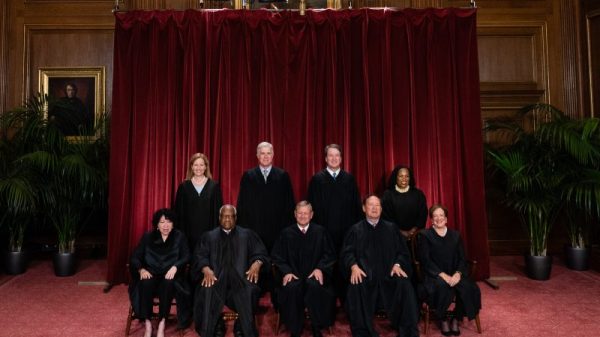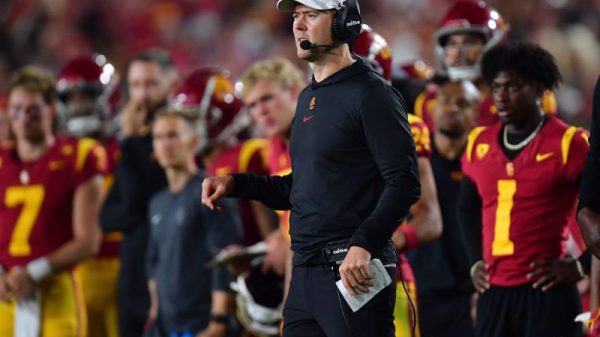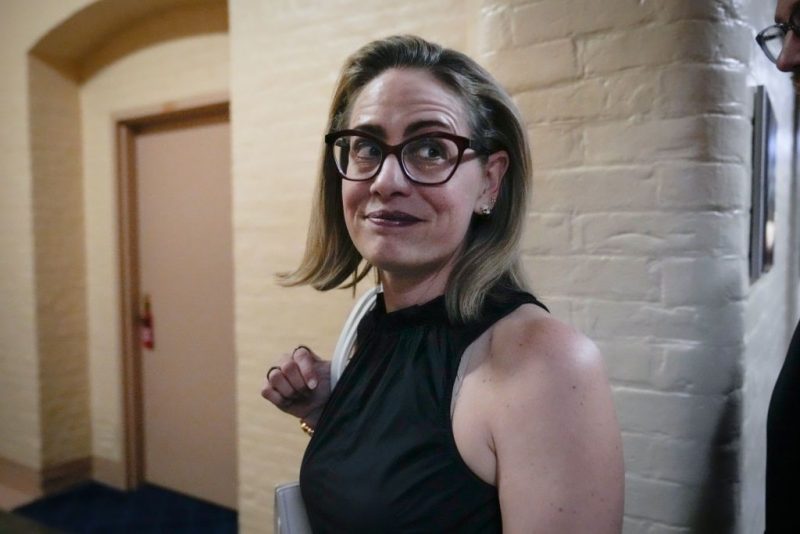There are a few reasons that party defections in the Senate draw more attention than those in the House — some of them admittedly obvious.
One is that there are fewer senators, meaning that a party switch has more of an effect. If one senator changes parties, that’s a change of 2 percent of the chamber (+1 percent to the lucky party and -1 percent to the unlucky one). An equivalent shift in the House would require the defection of five representatives. That weight also probably contributes to Senate defections. If you can completely upend the balance of power in Congress’s upper chamber all by yourself, well, that might make you more inclined to do so.
That senators represent entire states also probably plays a role. In many cases, defections reflect broader trends within states, things against which individual House seats might be better protected.
And so it is that Friday dawned with not-entirely-surprising news: Sen. Kyrsten Sinema, Arizona Democrat, was becoming Kyrsten Sinema, Arizona independent. As of writing, her status with the Democratic caucus is a bit unclear: She only sporadically caucused with them anyway. But the decision — like more than a dozen others over the past century-plus — suddenly reorganizes the Senate and, potentially, congressional power.
The history of Senate party switches extends back to the dawn of the two-party era, according to research from the Senate historian. In the late 19th century, there were switches rooted in the “remonetization of silver,” an issue that is so deeply buried in American history that we’re just going to skip those entirely. Below, the history of the other switches and, where applicable, how they reshaped the Senate.
1912: Sen. Miles Poindexter (Wash.). From Republican to Progressive.
We begin with Poindexter, one of multiple entrants on our list who switched parties briefly, only to switch back.
According to the Senate historian, Poindexter joined the nascent progressive movement. Coming into the 63rd Congress, he was the only seated independent. However …
1915: Sen. Mike Poindexter (Wash.). From Progressive to Republican.
Coming into the 64th Congress, he switched back. He had caucused with Republicans anyway.
1934: Sen. Robert La Follette Jr. (Wis.). From Republican to Progressive.
La Follette’s father is included on the Senate historian’s list, having sought the Progressive presidential nomination in 1924 while serving as a Republican. But La Follette Jr.’s switch was more traditional. His politics were more aligned with the growing progressive movement in the Midwest and he ran as a Progressive in 1934, winning election. He continued to caucus with Republicans.
1936: Sen. George Norris (Neb.). From Republican to independent.
Two years later, Norris — who had long been a relatively independent member of the Republican caucus — left the GOP to run as an independent. His bid was boosted by President Franklin D. Roosevelt, whom Norris had supported. He also continued to caucus with Republicans.
1940: Sen. Henrik Shipstead (Minn.). From Farmer-Labor to Republican.
Minnesota’s Farmer-Labor Party is now affiliated with the Democrats. In 1940, though, Shipstead caucused with the GOP before signing on with the party formally.
We’re cruising through these quickly, in part, because they involve political machinations that won’t mean much to modern readers. But then we come to the 1950s and Wayne Morse.
1953: Sen. Wayne Morse (Ore.). From Republican to independent.
Morse was elected to office as a Republican but declared himself an independent at the start of the 83rd Congress. His positions on policy issues had diverged from the party for some time.
“As the only third-party member on the Senate floor, he did not know where to sit, and set up a folding chair in the aisle between the Republican and Democratic sections,” the Senate historian reports. This was apparently not tenable, and eventually he moved his seat to the GOP side.
1955: Sen. Wayne Morse (Ore.). From independent to Democrat.
In early 1955, Morse upended the balance of power by changing his affiliation from independent to Democrat. This was the Lyndon B. Johnson era, and Morse got a plum committee assignment for his trouble.
You can see the shift below. In the 96-member body (Alaska and Hawaii hadn’t yet joined), the chamber was about evenly split before Morse’s defection. After, Democrats had a 49-47 advantage.
It didn’t last. The 1956 election brought new senators who shifted power back to the GOP. Among the new Democrats elected that year was a guy named Strom Thurmond.
1964: Sen. Strom Thurmond (S.C.). From Democrat to Republican.
Thurmond is, of course, a legendary figure in the Senate, serving past his 100th birthday. But he’s legendary, too, as a staunch segregationist.
Elected as a Democrat in 1956, he presaged the South’s broader partisan shift when he changed parties in 1964. The move had no effect on the balance of power; it was, instead, a reflection of Thurmond’s view of the Civil Rights movement.
A vitally important and telling shift for American politics that didn’t change the Senate much at all.
1970: Sen. Harry Byrd Jr. (Va.). From Democrat to independent.
Byrd’s switch in 1970 is also very instructive, particularly for the current moment.
“Political commentators suggested … that Byrd left the party because he no longer commanded Virginia’s Democratic base,” the Senate historian writes. “As an Independent, they argued, Byrd could attract a wider electorate without having to face a challenger in the upcoming primary election.”
More on this rationale for changing parties once we reach the party switch in 2022.
1994: Sen. Richard C. Shelby (Ala.). From Democrat to Republican.
Shelby was a relatively late addition to the South’s transition from Democratic to Republican. But the trigger was obvious: Republicans romped in 1994 and were poised to take control the following year. So while Shelby’s flip didn’t change the balance of power in 1994, it did mean he was still in the majority the following January.
1995: Sen. Ben Nighthorse Campbell (Colo.). From Democrat to Republican.
Soon after, there was another defection as Campbell decamped for the GOP. Remember, this was after the House flipped from blue to red for the first time in decades. It was a dramatic moment in how national power was arrayed. When Campbell flipped, the Republican majority improved, albeit slightly.
After he flipped, having won reelection as a Democrat in 1992, the Democratic Senatorial Campaign Committee sent him a bill for what it had spent on his campaign.
July 1999: Sen. Robert Smith (N.H.). From Republican to independent.
Let us now briefly discuss Robert Smith. Notice that we here include the month of his switch. That’s because …
November 1999: Sen. Robert Smith (N.H.). From Independent to Republican.
… when the death of Rhode Island senator John Chafee opened a good committee assignment, Smith flipped back to the GOP, noting that he never changed his party registration anyway.
2001: Sen. Jim Jeffords (Vt.). From Republican to independent.
One of the most dramatic defections in history came soon after the election of George W. Bush in 2000. The Senate was evenly split coming into the 107th Congress, with Vice President Dick Cheney casting tiebreaking votes. Independent-minded Sen. Jim Jeffords (R-Vt.) announced that he was becoming an independent a few months later — and that he would caucus with the Democrats.
Power flipped.
Jeffords remained in the Senate until 2007, when he was replaced as the state’s independent senator by Bernie Sanders.
2006: Sen. Joe Lieberman (Conn.). From Democrat to independent.
Joe Lieberman came within a few hundred Floridian votes of serving as the Democratic vice president from 2001 to 2005. By 2006, though, he was unpopular with Democrats nationally, having allied closely with the deeply unpopular George W. Bush on the war in Iraq.
Connecticut Democrats chose Ned Lamont — now the state’s governor — to be their Senate nominee in 2006. So Lieberman bailed, becoming an independent and winning reelection as a result.
2009: Sen. Arlen Specter (Pa.). From Republican to Democrat.
Specter, who had proposed a rule banning party switching in response to Jeffords’s defection, announced that he was leaving the GOP in April. He had come under fire from other Republicans for his policy positions — but he was also clearly concerned about his 2010 reelection bid.
Specter’s switch came at a particularly fraught time for the GOP. With his flip, the Democratic caucus had 59 votes, one shy of the margin needed to avoid Republican filibusters.
Specter’s effort to boost his reelection bid didn’t work. Democratic voters voted against him in the 2010 primary. Would this failure, then, mark the last time a senator unpopular with their party switched affiliations in an effort to improve their chances of reelection?
2022: Sen. Kyrsten Sinema (Ariz.). From Democrat to independent.
With that transition, we arrive at Sinema. She has been a frustration to Democrats nationally and in her state, too, and her decision to become an independent pretty clearly includes consideration of her ability to win a primary in 2024.
It also affects the balance of power in the evenly divided Senate — particularly when the 118th Congress convenes in January.
Again, it’s unclear at the moment if she’s going to be a true independent or still caucus with (and serve on committees on behalf of, as her office indicates) the Democrats. That latter option seems probable (although we indicated the uncertainty above with hatching on her square).
What history suggests, though, is that Sinema’s flip is relatively rare but certainly not unexpected. Particularly considering the well-worn precedent for embattled partisans deciding that their futures were better served by stepping away from parties entirely.































